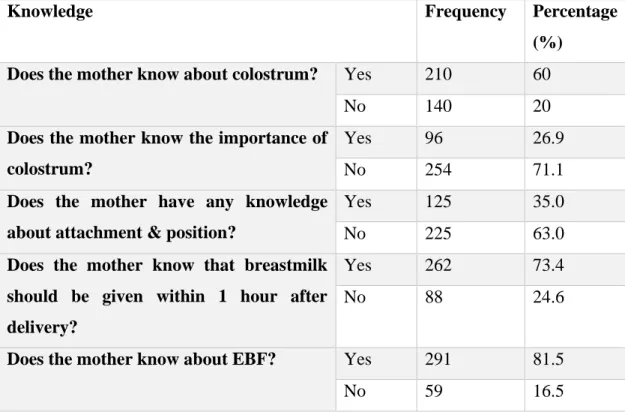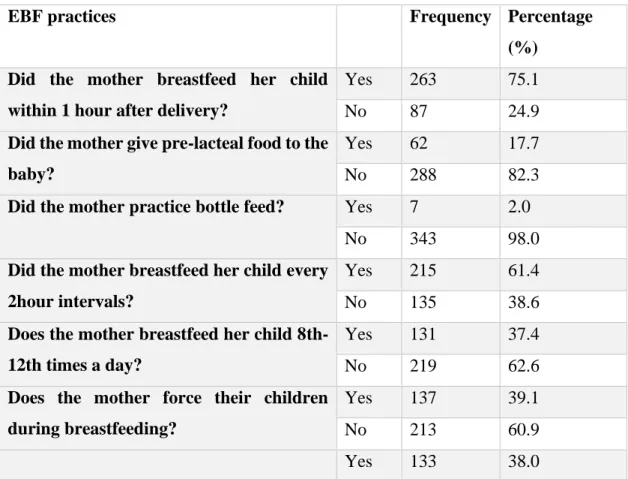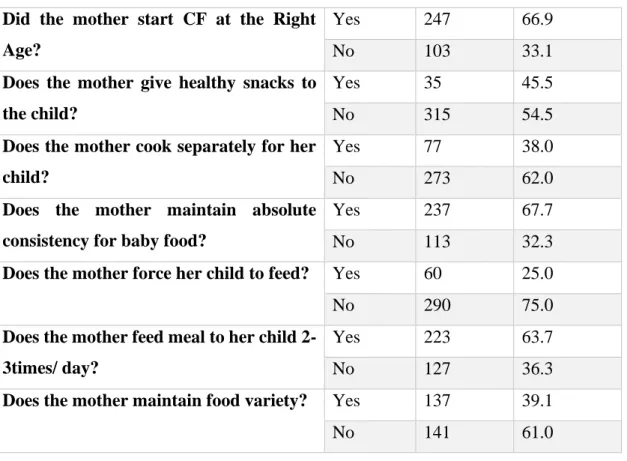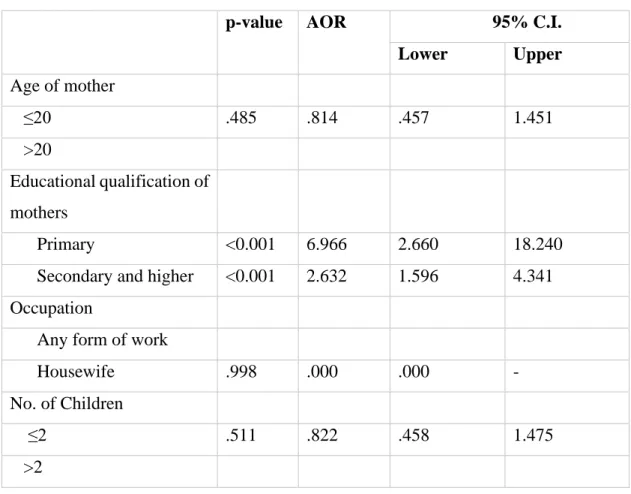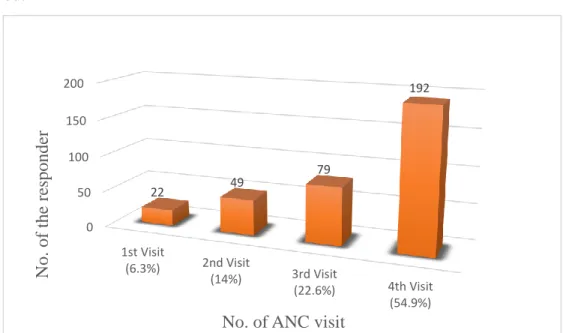KNOWLEDGE AND PRACTICES OF EXCLUSIVE BREASTFEEDING AND SUPPLEMENTARY FEEDING TO MOTHERS, ALONG WITH NEWBORN CARE IN A RURAL AREA OF COX'S. All praise to the Almighty “God”, the great, gracious, merciful and supreme ruler of the universe, who kindly allowed the author to complete her research work and write the thesis for the degree of Master of Science ( M.Sc. .) in Applied Human Nutrition and Dietetics.
Introduction
A study was conducted by Kabwijamu et.al., (2016) on newborn care among young mothers in Hoima district of Uganda. Another study was conducted by Sreeramareddy et.al., (2006) on home delivery and newborn care among urban women in western Nepal using a pre-test questionnaire.
Review of literature
Exclusive Breastfeeding (EBF) and Complementary feeding (CF)
It is important to remember that healthy complementary foods must be clean and safe to ensure the child's growth and development. Supplementary food should be fortified with calories, protein and micronutrients (especially iron, zinc, calcium, vitamin A, vitamin C and folate), etc.
Importance of Breastfeeding
Breastfed children require only non-liquid foods, while milk and semi-solid or solid foods should be provided to non-breastfed children (Shi et.al.,2010 & WHO, 2008). Improper breastfeeding is caused by premenopausal breast cancer, ovarian cancer, weight gain during pregnancy, type 2 diabetes, myocardial infarction and metabolic syndrome (Stube et.al., 2009).
Importance of Complementary feeding
According to Rouw et al. (2018) breast milk has a range of immunostimulatory, anti-inflammatory and antibacterial compounds and helps reduce the risk of short- and long-term morbidity. These data support the theory that early life consumption affects growth and body composition throughout development (Hopkins et.al., 2015).
Knowledge and practices of Exclusive Breastfeeding and Complementary
Inadequate complementary feeding was the cause of stunting in children despite optimal breastfeeding (Black et.al., 2008). Semahegn et.al., (2014) found that lack of education and gender-based discrimination affected complementary nutrition among mothers in Eastern Ethiopia.
Importance of Newborn care practice
Nutritional status of 6-23 months child
Experimental Area
Inclusion criteria
Exclusion Criteria
Experimental Design
The first segment was about socio-demographic factors (Age of mothers, educational qualification of mother, Mother's profession, age at first delivery, educational qualification of fathers, profession of fathers, father's income, religion, Type of family and number of children) of participants. Here, seven closed questions related to EBF knowledge, and another seven closed questions related to EBF practices, were asked in interview. The fourth segment was about newborn care practices; mothers were asked about the number of ANC and PNC visits; the type of delivery; the instruments used to cut the umbilical cord; and how umbilical cord dressing was done after delivery.
For anthropometry measurements, the height of the infants was measured by a flat wooden length measuring board, and weight was measured by SECA. Finally, the six-segment was the frequency of food intake, and the variety of food groups eaten by children in the last 24 hours was also recorded in the study. Before the start of the interview, the aims of this study were described to the mothers in a friendly manner, and their verbal consent was consciously taken.
Sample size estimation
Anthropometric measurement
- Measuring Mid-Upper Arm Circumference (MUAC)
- Procedure of Weight measurement (followed by UNICEF, 2022) is given
- Standardize the weighing scale (followed by UNICEF, 2022)
- Length and Height measurement procedure (followed by UNICEF,2022) 15
As the head touched the cursor, the child's head, shoulders, back, knees and heels were in contact with the board. Children under two years of age or less than 85 cm tall were selected for height measurement. The child's date of birth was checked on official documents provided by the guardian (eg health care, vaccination record, birth certificate) before height measurement.
The toes were pointed upward at a right angle and the soles of the feet lay flat on the base. If the child is taller than 85 cm and cannot stand, we must measure his height while lying down and subtract 0.5 cm from the total. The adjusted odds ratio (AOR) was observed to assess the strength of associations at 95% CI for the significance test.
The knowledge index was created by the sum of binary input variables, where the highest and lowest value was selected for each underlying indicator. The introduction of individual information was articulated using a unit-free index between 0 and 1, according to the structure technique of the Human Development Index. The score was created and then categorized into the groups labeled as poor and good knowledge and practices (UNDP, 2005; Ling et.al.,2011).
Socio-demographic information of the parents
Mother's Knowledge of EBF
EBF practices of mothers
Researchers from Ethiopia (Misgna et al., 2014) identified the factors that influenced mothers' attitudes towards complementary feeding methods and newborn care. BW et.al., (2020) had conducted a study among postnatal mothers in Nekemte town, Western Ethiopia, to find associated factors that influenced the level of maternal care for newborns. Middle and highly educated mothers are strongly associated with breastfeeding, as observed by Sanlio et.al., (2021) in Catania, Italy.
By providing optimal complementary feeding, about 6% of deaths among children under the age of five could be prevented (Black et.al., 2003).
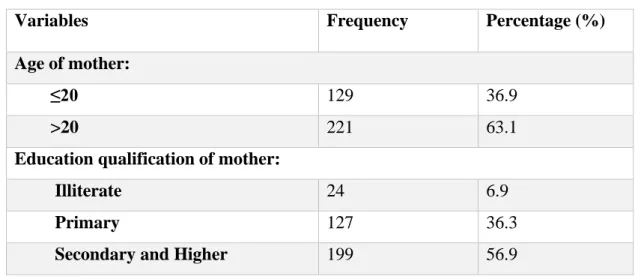
Mother’s knowledge of CF
Mother’s practices on CF
EBF knowledge according to socio-demographic characteristics
Breastfeeding knowledge, attitudes and practice among mothers with children under five (Mbada et.al., 2013; Oche et.al., 2011) and EBF knowledge and practices in Nigerian populations (Hackett et.al., 2015 ) showed global trends in EBF. The relationship between school-going girls' perceptions and knowledge of breastfeeding (Hackett et.al., 2015) and maternal knowledge and practices related to exclusive breastfeeding study was conducted in Ethiopia (Asfaw et.al ., 2015) has attracted special attention. To achieve a standard weight, growth and to minimize the risk of obesity during childhood, unnecessary protein content in complementary food should be avoided (Monteiro et.al., 2005; Ong et.al., 2006).
P a g e 10 | 70 Khanal et.al., (2013) found that whose father had at least one secondary education diploma was more likely to meet the recommended acceptable dietary standards.
Practices of EBF according to socio-demographic characteristics
The model explains 23% (Nagelkerke R2) of the variance in EBF knowledge and correctly classifies 73.4% of cases. Regression analysis was performed with the associated factors (educational qualification, occupation and country of birth) in this study. The model explains 25% (Nagelkerke R2) of the variance in EBF practice and correctly classifies 70.3% of cases.
Regression analysis is performed with the factors (mother's age, educational qualifications, occupation and number of children) associated with the practice of EBF in rural areas. Mothers who achieved primary level (adjusted odds ratio, (AOR confidence interval CI)) are more likely to have good practice with EBF compared to other factors.
Knowledge of CF according to socio-demographic characteristics
The model explains 98% (Nagelkerke R2) of the variance in CF knowledge and correctly classifies 99.1% of cases.
Practice of CF according to socio-demographic characteristics
The model explains 42.3% (Nagelkerke R2) of the variance in the practice of CF and correctly classified 76.9% of cases. Regression analysis is performed between associated factors (educational qualification, father's income and place of delivery) and practices of complementary feeding among.
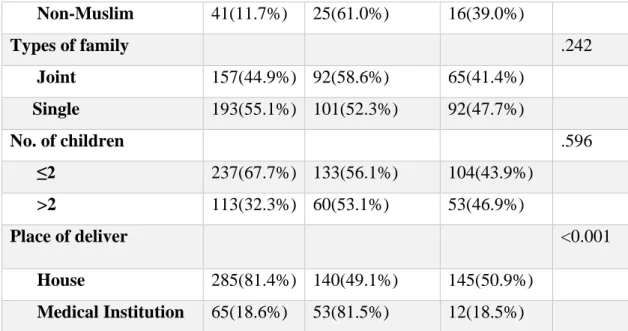
Newborn care practice
- ANC visit history of mothers during pervious pregnancy
- PNC visit history of mothers after previous delivery
- Place of delivery
- Type of delivery
- Instruments used during delivery to cut the umbilical cord
- Ingredients used for Umbilical Cord dressing
The study revealed that only 1.1% of mothers made four PNC visits, while 11.7% of mothers made two PNC visits, and 22.3% of mothers made only one PNC visit after delivery. This study shows that most mothers do not attend any postnatal PNC visits. On the other hand, about 18.6% (65 respondents) mothers have selected a medical institution such as a private hospital, government hospital, Upazila health complex, etc.
A graphical representation represents the data on "type of delivery" of the mothers from study area. About respondents) mothers went through normal delivery, and the other 10.9% (38 respondents) chose C-section. 34;Blade" is used in 80% delivery to cut umbilical cord instead of medical equipment by local midwives, observed in this study.
In this study, only 24.6% of mothers were found to use chlorhexidine (7.1%) for umbilical cord dressing. The finding showed that 23.5% of mothers used mustard oil for umbilical cord dressing and 16.3% of mothers used commercial umbilical cord dressing powder. Using mustard oil or any commercial powder instead of chlorhexidine can be harmful to the baby's health.
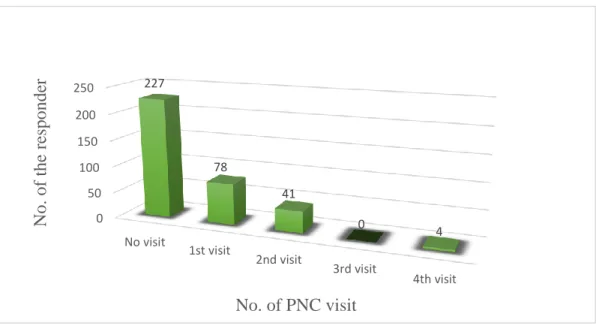
Nutritional status by using Anthropometry measurements
History of food intake in last 24 hours
History of feeding according to age
- History of feeding according to age (6-8 months)
- History of feeding according to age (9-11 months)
- History of feeding according to age (12-23 months)
On the other hand, about 26.9% mothers have knowledge about the importance of colostrum, while the previous study showed that about 63.7% mothers have knowledge about colostrum (Howlader et.al.,2020). Experimental research has shown that 61.4% of mothers breastfeed their child every two hours. The current research shows that only 62.6% of mothers breastfeed their child at least 8 to 12 times a day.
On the other hand, 39.1% mothers do not force their child's during breastfeeding, which is a good sign of feeding practices. In this study it is observed that 68.3% mothers have knowledge about the right age to start complementary feeding while only 66.9% mothers have done it. Shrestha et.al., (2020) has been conducted in a study in Nepal which indicates that about 64.4% mothers have knowledge about the age to start complementary feeding while only 55.6% mothers have done so.
This study expresses some important issues which have not been discussed before in Bangladesh, for example, only 25.7% of mothers have knowledge about the benefits of complementary feeding and 48% of mothers know that children should be given the right amount of food according to him/her. age. It was found that 35.1% of mothers have knowledge about food variety and 33.1% of mothers have knowledge about food groups. But this study shows that 67.7% of mothers have knowledge about the proper consistency of complementary food.
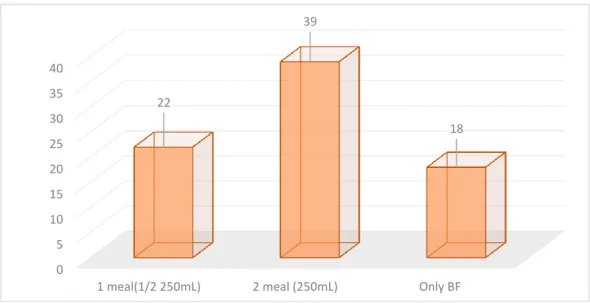
Limitations & Recommendation
Conclusion
Exclusive breastfeeding practice and related factors among mothers attending private pediatric and child clinics, Addis Ababa, Ethiopia: a cross-sectional study. Exclusive breastfeeding practice during the first six months of an infant's life in Bangladesh: a country-based cross-sectional study. Prevalence of exclusive breastfeeding and related factors among mothers in rural Bangladesh: a cross-sectional study.
Factors influencing the practice of exclusive breastfeeding among breastfeeding mothers in a peri-urban district of Ghana. Infant feeding practices of mothers and nutritional status of infants in Vhembe District in Limpopo Province, South African Journal of Clinical Nutrition. Exclusive breastfeeding knowledge and practices among mothers in rural areas of Rajshahi district in Bangladesh: A community clinic-based study.
Factors associated with exclusive breastfeeding practices among mothers in Goba District, Southeast Ethiopia: a cross-sectional study.
